|
|
|
Sort Order |
|
|
|
Items / Page
|
|
|
|
|
|
|
| Srl | Item |
| 1 |
ID:
114437


|
|
|
|
|
| Publication |
2012.
|
| Summary/Abstract |
Traditional analyses of Switzerland's nuclear weapons program often explain both its beginning and its end by merely subsuming it under the broad logic of security calculations: the country originally developed an interest in nuclear weapons due to its precarious security environment after the end of World War II; it ended its nuclear ambitions roughly two decades later when it felt less threatened by external powers. Yet this depiction of the Swiss case brushes aside the historical political context in which Switzerland's nuclear decision-making was embedded. Drawing upon studies in sociology and political theory, this article argues that understanding the Swiss debate on nuclear weapons is possible only if we manage to comprehend the significant political and cultural changes that took place within Swiss society. These changes deeply affected the country's defense and foreign policy conceptions and also altered prevalent notions of neutrality, thereby ultimately foreclosing the nuclear option. In more abstract theoretical terms the article moreover suggests that we need to overcome depictions of objectively given threats or predetermined interests and develop analytical tools that help us disentangle the complex, non-linear ways in which threat perceptions, identities, and preferences evolve and shape states' proliferation policies.
|
|
|
|
|
|
|
|
|
|
|
|
|
|
|
|
| 2 |
ID:
119062


|
|
|
|
|
| Publication |
2013.
|
| Summary/Abstract |
The nonproliferation of weapons agenda was entirely about chemical, biological, radiological, and nuclear weapons because they were seen as the most threatening to human existence and the security of the most powerful countries. Small Arms and Light Weapons (SALW), which have been instrumental to massive destruction of life and property, began to receive a serious attention from world leaders in the 1990s. Consequently, this article is concerned with the problems of controlling the proliferation of SALW in the Niger Delta of Nigeria. It argues that supply implicitly obeys the demand for SALW because it lacks a control factor. The presence of such a factor makes the acquisition of nuclear capability very difficult. Therefore, the effective control of SALW's proliferation would depend not only on controlling local demand factors but also on the presence of a supply control factor.
|
|
|
|
|
|
|
|
|
|
|
|
|
|
|
|
| 3 |
ID:
172569


|
|
|
|
|
| Summary/Abstract |
Current dynamics in UCAV proliferation in the Middle East signal that combat drones have become key strategic enablers for state actors in the region, and are no longer seen as an optional asset. With the development of a multitude of indigenous UCAV projects, and the arrival of Chinese-made armed drones on the international market, military procurement in the Middle East has entered a new phase, in which possessing armed drone capabilities is becoming the norm. This article examines the operational and strategic considerations driving Middle Eastern states’ UCAV procurement policies, analysing those countries who have been focusing on armed drones for combat purposes and additional intelligence, surveillance, target acquisition, and reconnaissance (ISTAR) needs. The main drivers behind this trend are the operational and strategic advantages brought about by UCAVs, where the benefits related to cost, reliability, and operational risk mitigation are matched by the increased ability to project power that the platform allows, either through deniability or by making UCAVs available to proxies and allies.
|
|
|
|
|
|
|
|
|
|
|
|
|
|
|
|
| 4 |
ID:
113950
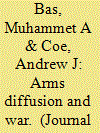

|
|
|
|
|
| Publication |
2012.
|
| Summary/Abstract |
The authors present a model of the relationship between the spread of new military technologies and the occurrence of war. A new technology could shift the balance of power, causing anticipatory war as one side tries to prevent the other from obtaining it. When one side already has it, war is more likely when the shift in power is large, likely, and durable. When neither side has it, war is more likely when the expected shift is asymmetric (e.g., one side is more likely to get it) and when the two sides fear that a war will occur once one of them has it. The authors illustrate the model with historical examples from the spread of firearms (the Musket Wars in precolonial New Zealand) and of nuclear weapons (the end of US nuclear monopoly and the 1967 Six-Day War). A broader implication is that major power competition can unintentionally cause wars elsewhere.
|
|
|
|
|
|
|
|
|
|
|
|
|
|
|
|
| 5 |
ID:
154928
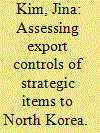

|
|
|
|
|
| Summary/Abstract |
This paper aims to show trading patterns of certain items highly likely to be used
to develop nuclear and missile programs in North Korea. It analyzed North Korea’s
trade of nuclear―and missile―related items for ten years from 2006 to 2015 to
identify items in large volume as well as in increased demand and key suppliers
that contribute to sanctions―busting. This paper found that UN sanctions against
North Korea were not effective in controlling the flow of strategic items to North
Korea. Rather, a small number of states are responsible for a large share of trade
with North Korea that has continued to seek alternative suppliers. It also found
that China is a single supplier for multiple items and plays a major role along with
several others that either specialize in exports of specific items or gradually expand
the scope of supplies. Because the presence of a third country that provides North
Korea’s resilience and diversion of sanctions is crucial, this paper recommends
policy suggestions to enhance effectiveness of the existing sanctions regime.
|
|
|
|
|
|
|
|
|
|
|
|
|
|
|
|
| 6 |
ID:
087337
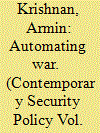

|
|
|
|
|
| Publication |
2009.
|
| Summary/Abstract |
New technological developments in the area of robotics and artificial intelligence have made robotic weapons systems of increasing autonomy possible. Although thousands of unmanned systems have been deployed, the vast majority are unarmed, used primarily for reconnaissance or removal of explosives. But deployment of armed robotic weapons has begun and promises to accelerate rapidly in the next decade. This article begins by proposing definitions of autonomous or robotic weapons, outlines the most important obstacles to their introduction, and options for arms control. It makes three claims: first, robotic weapons such as unmanned vehicles could largely replace human soldiers in the battlespace in one or two decades; second, for technical, economic, and operational reasons robotic weapons will become increasingly autonomous; finally, these new types of conventional weapons could result in new dangers to international security that should be addressed before the weapons are introduced and proliferate widely. It is suggested that an outright ban would be unlikely to be successful and that it may not even be desirable. A ban of particular types of offensive automatic weapons (AW) and special provisions on defensive types would make most sense.
|
|
|
|
|
|
|
|
|
|
|
|
|
|
|
|
| 7 |
ID:
169460
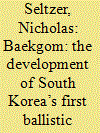

|
|
|
|
|
| Summary/Abstract |
This article traces and analyzes the development of South Korea’s first ballistic-missile system from 1971 through 1978 based on memoirs and personal accounts by scientists and officials directly involved in missile development during this time. The system is often described as a reverse-engineered copy of the Nike Hercules, a US surface-to-air missile, but this description does not capture the true character of South Korean missile development during the 1970s. By working on the Nike Hercules-based design in cooperation with American and French contractors, South Korea’s weapons specialists gained experience and built facilities that underpinned autonomous missile development for decades afterward. The accounts of South Korean weapons scientists also demonstrate that tacit knowledge—subtle or secret methods and tricks transmitted in person from mentors to protégés rather than written down in textbooks or manuals—can play a crucial role in building successful weapons programs and capable research-and-development capacities.
|
|
|
|
|
|
|
|
|
|
|
|
|
|
|
|
| 8 |
ID:
132479
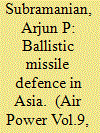

|
|
|
|
|
| Publication |
2014.
|
| Summary/Abstract |
The one continent where ballistic missiles have proliferated tremendously is Asia. There are some important factors that have been, and are, contributing to such a trend in the region. Firstly, the demand for the ballistic missile as it is a relatively cheap weapon to develop and deploy compared to a large and sophisticated air force. Also, this weapon is hard to counter even by the most technologically advanced countries. Secondly, the existing geo- political make-up where confrontation is between states that are at opposite poles of the power spectrum, where the weaker side finds such weapons most suitable to counter a technologically superior adversary. Thirdly, the ready availability of the technology and vital components through both legal and clandestine means. These factors have enabled states like North
Korea with a less than meagre technology base to adapt the technology, of course, with tremendous assistance, to develop ballistic missile capability. With the rapid proliferation of these weapons in Asia, countries facing this threat have been looking for ways to counter it. Most have turned to some level of Ballistic Missile Defence (BMD). This paper attempts to study the ballistic missile threat and the missile defence efforts of the US and its allies in East Asia, China, Israel and India.
|
|
|
|
|
|
|
|
|
|
|
|
|
|
|
|
| 9 |
ID:
082408


|
|
|
|
|
| Publication |
2008.
|
| Summary/Abstract |
This analysis examines ballistic missile proliferation in the context of strategic interactions among neighboring states. The analysis finds that when faced with ballistic missile threats, nations respond rationally and acquire ballistic missiles as a deterrent. Using a panel data set of 119 countries from 1967 to 1997, this study shows that the probability of a country procuring ballistic missiles increases nonlinearly as the number of bordering states with ballistic missiles increases. Although international norms arising from the Missile Technology Control Regime reduced the probability of missile proliferation, these externalities did not offset a state's decision to arm in response to ballistic missile arsenals in neighboring states. This analysis also finds that surface-to-air missiles (SAMs) increased the probability of proliferation in two ways: first, because ballistic missiles provided states ``ensured penetration'' of a rival's air defenses; and second, because SAMs reduced the ability of a rival to retaliate against a ballistic missile attack
|
|
|
|
|
|
|
|
|
|
|
|
|
|
|
|
| 10 |
ID:
124141
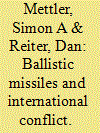

|
|
|
|
|
| Publication |
2013.
|
| Summary/Abstract |
Governments are concerned about the dangers posed by ballistic missiles. However, there is almost no theoretical or empirical scholarship on ballistic missiles. This article presents and tests the conventional wisdom that the spread of ballistic missiles makes conflict more likely. Original data on ballistic missiles and on crisis initiation is collected, and analysis using a variety of statistical models is conducted. It is found that among all directed dyads from 1946 to 2007, potential challengers possessing ballistic missiles are significantly more likely to initiate international crises. Further, potential targets armed with ballistic missiles are significantly less likely to be challenged. Crises are less likely to escalate when targets are armed with missiles. The results are obtained after accounting for several control variables. Analysis reveals that the findings are not affected by possible endogeneity bias. The analysis also reveals complex interactive effects between ballistic missiles and nuclear weapons on the onset of international crises.
|
|
|
|
|
|
|
|
|
|
|
|
|
|
|
|
| 11 |
ID:
105207
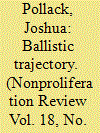

|
|
|
| 12 |
ID:
072629
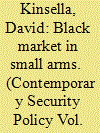

|
|
|
|
|
| Publication |
2006.
|
| Summary/Abstract |
In recent years, researchers have increasingly turned their attention to the proliferation of small arms, a transnational trade amounting to over $7 billion in value during 2002. Small arms are difficult to track and are not the stuff of military parades, but they are immensely destructive. As much as $1 billion worth enters the black market annually. I argue that the illicit trade in small arms should be understood not as a market but as a network, one that shares some important properties with networked forms of organization studied by sociologists. I then employ quantitative methods developed for the study of social networks in an effort to show the basic structure of illegal small arms transfers to Africa. The analysis draws from my Illicit Arms Transfers dataset still in development, so the results make use of the most rudimentary information being collected. They are suggestive, however, and the analytical approach promises to shed considerable light on a corner of the global arms trade that is of great interest to the research and activist communities, and of great consequence to those in war-torn regions of the world.
|
|
|
|
|
|
|
|
|
|
|
|
|
|
|
|
| 13 |
ID:
143304
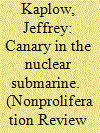

|
|
|
|
|
| Summary/Abstract |
The Treaty on the Non-Proliferation of Nuclear Weapons (NPT) allows states to exempt nuclear material from international safeguards for use in nuclear submarine programs. This material, however, could be diverted for nuclear weapons purposes without the knowledge of inspectors, creating a potentially dangerous loophole in the treaty. This article argues that exercising that loophole today would amount to admitting a nuclear weapon program, making it a particularly poor pathway to a weapon for a potential proliferant. Still, if states like Brazil ultimately exempt nuclear material from safeguards for a nuclear submarine effort, they could set a dangerous precedent that makes it easier for others to use the loophole as a route to a nuclear weapon capability. There are several policy options available to mitigate the damage of such a precedent; most promising is the prospect of a voluntary safeguards arrangement that would allow international inspectors to keep an eye on nuclear material even after it has been dedicated to a naval nuclear propulsion program.
|
|
|
|
|
|
|
|
|
|
|
|
|
|
|
|
| 14 |
ID:
156589
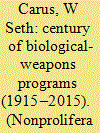

|
|
|
|
|
| Summary/Abstract |
This article reviews what is known about the proliferation of biological-weapon programs during the past century. Collecting information on biological-weapon programs is difficult, even for intelligence organizations, and there is limited information available on the extent and character of past programs. A review of the open-source literature supports claims that twenty-three states had, probably had, or possibly had a program. The number of active programs has varied over time, from a low of zero in 1920 to a high of possibly as many as eight in 1990. Program size and sophistication also has varied enormously; most were small and unsophisticated, and many existed for only a short period of time.
|
|
|
|
|
|
|
|
|
|
|
|
|
|
|
|
| 15 |
ID:
172095
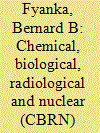

|
|
|
|
|
| Summary/Abstract |
The post-Cold-War collapse of the Soviet military-industrial complex has enabled the rapid global proliferation of nuclear weapons and fissile material, thereby escalating the possibilities of non-conventional nuclear attacks. Such attacks have become more likely with the emergence of very powerful terrorist groups like Boko Haram and others around the world. Over 1,800 metric tons of nuclear material is still stored in poorly secured facilities in more than 25 countries. The International Atomic Energy Agency (IAEA) as at December 2015 had recorded in their trafficking database a total of 2,889 incidents involving losses, thefts and attempts to traffic fissile material across international borders. Boko Haram may also engage with radiological or biochemical ‘dirty bombs’, which are easier to make. With no less than 48 reported incidences of biochemical attacks since 1900, it is likely that Boko Haram may switch tactics, especially considering the lack of biochemical detection protocols in Nigeria’s counterterrorism strategy and also the inconsistency in public and private sector collaboration. This new reality calls for a recalibration of Nigeria’s counterterrorism protocols to accommodate the anticipated threat. The paper thus highlights policy considerations and advocates new directions.
|
|
|
|
|
|
|
|
|
|
|
|
|
|
|
|
| 16 |
ID:
144815
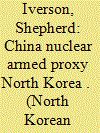

|
|
|
| 17 |
ID:
121904
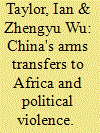

|
|
|
|
|
| Publication |
2013.
|
| Summary/Abstract |
Chinese arms sales to Africa have increased in recent years. In a region beset by conflict and unstable regimes, and where arms sales are a significant and positive predictor of an increased probability of political violence, this is inherently problematic. The sale of weaponry to a regime in Khartoum caught up in an alleged "genocide" in Darfur, the awkward appearance in 2008 of a Chinese ship loaded with weapons bound for Mugabe's Zimbabwe off the coast of eastern Africa, and the recent exposure in 2011 that Chinese arms companies offered to sell around $200 million worth of arms to Muammar Gaddafi's regime are emblematic of an issue in Africa's political violence that needs analysis. This article seeks to discuss the rationale behind China's arms sales to Africa and the effect that they have had on political violence in recipient countries. It also provides an analysis of the supply-and-demand circumstances of Chinese arms transfers to Africa, Beijing's attempts to control such transfers, and evidence that Chinese policies on proliferation are (slowly) evolving.
|
|
|
|
|
|
|
|
|
|
|
|
|
|
|
|
| 18 |
ID:
089367
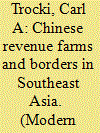

|
|
|
|
|
| Publication |
2009.
|
| Summary/Abstract |
This article examines the role of Chinese revenue farmers in defining the borders of the various colonial territories and the states of Southeast Asia during the nineteenth century. Their significance has largely been neglected in writing on the formation of state boundaries. Nicholas Tarling notes, 'Between the late eighteenth and the early twentieth almost all southeast Asia was divided into colonies or protectorates held by the Western powers, and new boundaries were drawn with the object of avoiding conflict among them' (Tarling, 2001:44). This paper argues that Chinese revenue farmers were of considerable significance in giving substance to the formalistic pronouncements of remote diplomats and statesmen.
|
|
|
|
|
|
|
|
|
|
|
|
|
|
|
|
| 19 |
ID:
186333
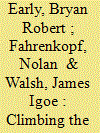

|
|
|
|
|
| Summary/Abstract |
Why do some states possess more advanced military technologies than others? Our study explores the vertical proliferation of land-attack cruise missiles (LACMs), seeking to understand which demand- and supply-side factors best explain why some countries acquire more sophisticated LACMs. We theorize that states’ security environments, regime types, possession of related strategic technologies, and membership in the Missile Technology Control Regime (MTCR) influence the possession of more sophisticated cruise missiles. Our analysis employs a unique new global dataset with granular data on every LACM national militaries have deployed. We use this dataset to evaluate the proliferation of LACMs across the international system from 1991–2015. Using a selection model that first controls for the horizontal proliferation of LACMs, we find that insecurity, scientific and technical expertise from related technologies, the possession of highly authoritarian and highly democratic regimes, and MTCR membership all have positive effects on the sophistication of LACM-possessors’ arsenals.
|
|
|
|
|
|
|
|
|
|
|
|
|
|
|
|
| 20 |
ID:
115364
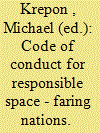

|
|
|
|
|
| Publication |
Washington DC, Stimson Center, 2010.
|
| Description |
81p.
|
|
|
|
|
|
|
|
|
|
|
|
Copies: C:1/I:0,R:0,Q:0
Circulation
| Accession# | Call# | Current Location | Status | Policy | Location |
| 056813 | 629.1/KRE 056813 | Main | On Shelf | General | |
|
|
|
|
|
|
|
|
|